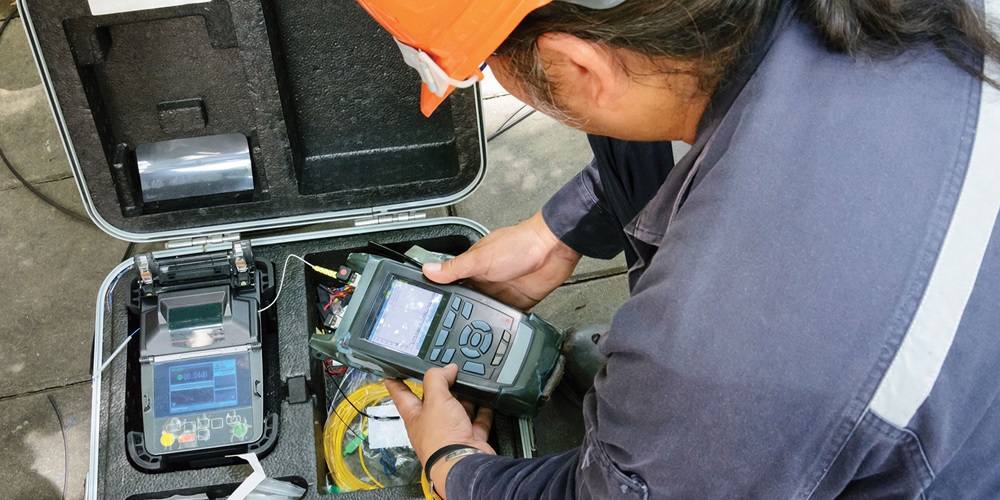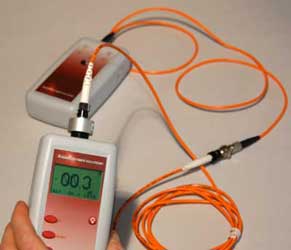Discover the Importance of Optical Fibre Screening in Modern Telecommunications
In the realm of modern-day telecoms, the significance of optical fibre screening can not be overemphasized, as it offers as the backbone for making sure network dependability and performance. What are the details advantages that regular testing deals, and how might it shape the future landscape of telecoms?

Recognizing Optical Fibre Screening
Optical fiber testing is an important procedure in telecommunications that makes sure the stability and performance of fibre optic networks. This testing includes a variety of treatments created to assess the physical and functional characteristics of optical fibers - optical fibre testing equipment. Key criteria assessed consist of optical power loss, data transfer capability, and mistake place, which are important for maintaining high-grade interaction web links
The testing procedure commonly entails using customized devices such as Optical Time-Domain Reflectometers (OTDR) and Optical Power Meters. OTDRs are utilized to identify and define faults, entwines, and connectors within the fiber, while power meters measure the transmitted light signal stamina to identify efficiency.
Moreover, screening is carried out at numerous stages, including throughout setup, maintenance, and troubleshooting, to make sure that the network meets sector requirements and operational needs. Conformity with requirements set by companies like the International Telecommunication Union (ITU) and the Telecommunications Sector Organization (TIA) is extremely important.
Advantages of Routine Checking
Normal testing of optical fibres returns numerous benefits that significantly enhance network dependability and efficiency. Among the main advantages is the very early detection of potential problems, such as breaks or deterioration in the fiber, which can cause pricey downtime if left unaddressed (optical fibre diameter analyser). By identifying these troubles proactively, telecommunications carriers can lessen solution interruptions and make sure regular connectivity for their customers
Furthermore, normal screening aids to keep the integrity of signal top quality. As optical fibres age, their performance can be affected by factors such as environmental conditions and physical stress. Regular assessments enable for the surveillance of signal loss and general transmission efficacy, making sure that the network runs at optimum levels.
An additional significant benefit is compliance with industry requirements. Routine testing supports adherence to governing demands, therefore minimizing lawful and monetary threats related to non-compliance. Moreover, it enhances the general life-span of the fibre framework by assisting in prompt repair and maintenance.

Usual Evaluating Approaches
Testing optical fibers employs various techniques to ensure the stability and efficiency of telecommunications networks. Amongst the most common strategies is Optical Time Domain Reflectometry (OTDR), which assesses the entire size of the fibre by sending out a pulse of light and measuring the representations triggered by blemishes or breaks. This technique supplies detailed details about the area and extent of mistakes.
One more prevalent approach is making use of Optical Power Meters, which gauge the quantity of light transmitted with the fiber. This strategy helps determine the loss of signal toughness, guaranteeing that it satisfies industry criteria. Additionally, Aesthetic Mistake Locators (VFL) are used to identify breaks or extreme bends in the fiber by projecting a noticeable laser light right into the cord.
Insertion loss testing is likewise critical, as it measures the loss of signal power resulting use this link from connections and mates within the network. Moreover, using Polarization Setting Diffusion (PMD) screening evaluates the effect of fibre characteristics on signal honesty.
Each of these techniques plays an important role in keeping the performance and integrity of optical fibre networks, eventually adding to seamless telecoms operations.
Influence on Network Performance
The integrity and efficiency of optical fiber networks directly affect general network performance. In modern-day telecommunications, the efficiency of information transmission depends heavily on the high quality of the optical fibres used. Any type of deterioration in the fiber's problem-- whether as a result of physical damages, contamination, or extreme bending-- can result in raised depletion and signal loss, considerably influencing data integrity and speed.
Regular optical fibre testing is important to recognize and fix possible problems before they show up as network failures or slowdowns. Methods such as Optical Time Domain Name Reflectometry (OTDR) and insertion loss screening enable service technicians to gauge the efficiency of fiber web links precisely. These tests not just review the physical problem of the fibers however also make certain conformity with sector requirements, therefore protecting the network's reliability.
Moreover, a properly maintained optical fibre network adds to minimized functional expenses and boosted consumer fulfillment, as end-users experience fewer disturbances and greater data rates. Ultimately, the emphasis on extensive optical her latest blog fibre screening practices offers as a keystone for sustaining durable telecoms framework, making sure that provider can meet the expanding demands for bandwidth and connection in today's digital age.
Future Patterns in Testing
As we look ahead, innovations in modern technology are poised to reshape optical fibre screening in telecoms. The rise of automation and expert system (AI) is expected to improve the performance and accuracy of testing processes. Automated testing systems can perform comprehensive assessments with marginal human treatment, considerably decreasing the possibility for mistakes and quickening time-to-deployment.
In addition, the combination of device understanding algorithms will certainly make it possible for predictive upkeep, allowing network service providers to visualize possible problems prior to they rise right into failures. This proactive technique not only improves network integrity yet additionally enhances operational costs.
One more arising pattern is the development of mobile testing devices that offer real-time analysis - optical fibre testing equipment. These tools will certainly empower specialists to execute on-site diagnostics rapidly, helping with quicker resolutions and enhancing solution quality
The development of 5G networks better necessitates the advancement of testing methods. As bandwidth demands increase, typical screening strategies might no much longer i thought about this are enough. Ingenious remedies such as optical time-domain reflectometry (OTDR) and advanced spooky evaluation will certainly come to be essential in guaranteeing the honesty and performance of high-speed connections.

Conclusion
To conclude, optical fibre screening is necessary for ensuring the honesty and reliability of modern-day telecommunications networks. Routine screening methods not just help recognize potential issues such as signal loss and faults yet likewise add to improved network efficiency and client fulfillment. As the demand for seamless connection remains to grow, the adoption of innovative screening methods will play an important role in preserving top quality network criteria and supporting the advancing landscape of telecommunications.